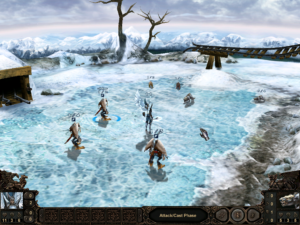Etherlords: Skill Gain
Well, I’ve finally gotten past map 3 in the red/black campaign. I found it easier than the corresponding scenario in the blue/green campaign, but I’m not sure if this is because it actually is easier or because I’m getting better. The use of overland spells seemed important to my victory, but I don’t remember seeing the obelisks that you learn them from in blue/green map 3. Were they absent, or did I just not notice them because they look too much like normal terrain features? I’ll have to go back and find out at some point. If it turns out that I’m just getting the hang of things, all I can say is that the learning curve for the strategic part of the game is pretty steep. Probably the designers didn’t spend as much time on it as they did on combat mode, which is clearly the heart of the game.
Regardless, to a certain extent getting this far was luck of the draw. You might expect that to be the case for something with card-game-like gameplay, but that isn’t even the part of the game I’m talking about. Whenever a hero gains a level, he also gains a skill. Skills are things like Strength (extra hit points) and Resources (lets you carry more runes) and Concentration (draws extra spells during combat). Each can be taken up to 3 times with cumulative effects. There are 15 different skills, but you don’t get to choose from the full set when you level — instead, you have to choose from three that the game picks for you at random. Heroes of Might and Magic does something similar. It’s a nice compromise, if you ask me. If you let the player choose whatever skills they want, they’ll probably assign the same skills to every hero and not get much variation in gameplay, and if you just assign a skill at random without letting the player choose, the player will be frustrated every time they get stuck with something they don’t want and probably wind up loading a save and trying again (kind of like when hit point gains are randomized). Limited choice within a randomized field mitigates both problems.
Or at least it does if the skills are reasonably balanced. In Etherlords, there are a few skills that really help a lot. Gaining experience levels faster than the enemy heroes is important, so Learning (bonus experience) is a more valuable skill than most. Perhaps unintuitively, Mobility (move farther per turn) helps even more. The main source of XP is wild monsters, and a lot of the time they’re spaced out just far enough that a normal hero can almost but not qute travel between them in one turn. In such circumstances, Mobility effectively doubles the rate at which you gain XP. And if one of your heroes gets both Learning and Mobility at once, well, you’ll find it a lot easier to get through red/black map 3. I speak from experience.
 Comments(1)
Comments(1)